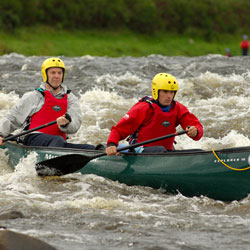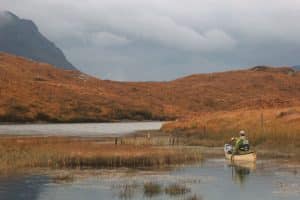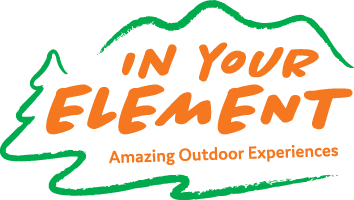 If you’re new to canoeing or just haven’t been out paddling for a long time, here are some suggestions/reminders about the kind of kit you should think about having when out paddling your favourite loch, or if exploring a new Highland River. The items near the top of the list are the ones you are likely to need sooner than the ones at the bottom.
If you’re new to canoeing or just haven’t been out paddling for a long time, here are some suggestions/reminders about the kind of kit you should think about having when out paddling your favourite loch, or if exploring a new Highland River. The items near the top of the list are the ones you are likely to need sooner than the ones at the bottom.
- PFD or lifejacket: PFD (personal floatation device), Buoyancy Aid or Life Jacket is an essential. Going out in a canoe without some sort of personal floatation is asking for trouble.
- Paddle: Goes without saying that you will need a paddle. The choice of paddle is almost as difficult as the choice of canoe. As with the canoe the secret is to try as many styles as possible and go for the one that suits you best.
- Spare Paddle: Without a spare paddle eventually you WILL be up the creek without a paddle. Paddling a canoe with your hands can be hard work.
- Whistle: An essential piece of safety equipment. Have it with you always. The sound of a good whistle will carry far further than the loudest of shouts.
- First Aid Kit: If you don’t know why you should have one of these then you really should not be going out anywhere. A first aid kit should be checked and restocked regularly. The size of the kit should reflect the length of the journey.
- Bail & Sponge: You will get some water in your canoe. Hopefully it will just be a small amount which you can take care of with the sponge, however, at some point you are likely to need to bail out a larger amount. Trying to use the canoe when it is half full of water is pretty difficult, and in heavy weather damn near impossible!
- Rope / Chord: At the very least you will want enough cordage to tie your stuff to the canoe so that if you suffer a capsize it does not all drift away. (Dog leads from the £1 shop are handy for this). You will also want some rope at the ends of your canoe to tie it up if you land at a jetty (this is called a painter rope).
- Knife: Knives have suffered a bad press lately but it is essential that you have a knife with you in an open canoe. With chord and rope about it is essential that you have the means to cut yourself free if you become entangled. The knife must be easily accessible. A fixed blade is strongly recommended over a folding one. Serrated blades will handle rope better that smooth.
- Dry Bag: Obv
 ious really. From keeping your lunch dry to your phone and car keys. And make sure your sleeping bag stays dry! Dry bags come in every size you could need and are reasonably priced.
ious really. From keeping your lunch dry to your phone and car keys. And make sure your sleeping bag stays dry! Dry bags come in every size you could need and are reasonably priced. - Dry Clothes: For a short trip leave some back in the car, or more usually in the Dry Bag. You know it makes sense.
- Throwline: This is a length of rope in a bag, which as the name suggests you can throw. It can be thrown to another canoe needing rescue, streaming the rope behind it. Or it can be thrown to help on the land. If you suffer a capsize you can also grab it and swim for shore, hopefully reaching shore before the rope runs out. Thus enabling you to pull the canoe ashore rather than having to swim it ashore.
- Air Bags / Buoyancy: These large air filled bags can be tied into the front, rear and middle of the canoe. These keep the canoe afloat and high in the water even if swamped. A similar effect can be obtained by having all your stuff in dry bags securely lashed in to the canoe.
- Hat: There is no shade on the water so a wide brimmed hat is an essential in the summer and handy for keeping the rain off in the winter. A warm wool hat is also a good idea as when it is cold there is no shelter from the wind. A wool hat will retain a lot of its insulation even when wet.
- Polarised Sunglasses: Any sunglasses will be handy but polarised ones will really cut down the glare from the water.
- Footware: There are various opinions on this and it will depend on the season, but essentially your foot is going to go into the water at some point and you need to be prepared for that. Also, you want it to be something that will not hamper you too much if you have to swim and is comfortable when paddling.
- Knee Pad: A soft mat to kneel on when you are paddling. Of course you may c
 hoose to sit but kneeling generally gives you more control. Without a mat your knees will suffer.
hoose to sit but kneeling generally gives you more control. Without a mat your knees will suffer. - Food and Water: Always a good idea to have some food to top up your energy levels and water to stop you getting dehydrated.
- Pole: You do not always paddle. A pole can be used for making progress against the current and in shallow water in heavy weather. They are also useful when lashing canoes together or for pitching a tarp.
- Plastic Barrels: Usually used for storing kit. Fairly waterproof but best to have a dry bag inside. Will protect gear from bashing etc.
- Sail: Yes, you do not need to paddle all the time. There are a range of sails available for open canoes. From the simple to the sophisticated.
- Trolley / Wheels: For transporting your laden canoe over relatively short distances.
- Drogue / Sea Anchor: Like a mini parachute this can be used to stop you drifting in the open water.
Please note that this is not an exhaustive list of kit, but hopefully will give you some things to think about when putting together your own stuff. You can get more advice from the Discover Canoeing guidebook.
Happy paddling.
